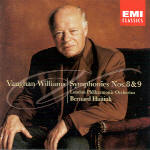The accolades that Bernard Haitink’s wretchedly dreary Vaughan Williams cycle consistently receives in the UK only serve to prove, as if further proof were necessary, just what poor custodians of their musical culture so many British critics are. The performances in this cycle have been uniformly dismal, but this last disc in the series plumbs new depths of dullness. Perhaps you thought that Haitink already had hit bottom with his unspeakably boring Covent Garden La Forza del Destino a couple of years ago. No such luck. If he keeps on this way, the only fitting epitaph when he finally goes will be Dorothy Parker’s celebrated line on being told that Calvin Coolidge had died: “How can they tell?” she quipped.
What makes this disc so atrocious isn’t just that Haitink’s inimitably tedious style manifests itself in slower than desirable tempos. No indeed; he achieves an apotheosis of dullness that includes rhythm, phrasing, dynamics, and timbre in a sort of multidimensional extravaganza of ennui. Take the opening movement of the Eighth Symphony: lovely, isn’t it? But is that really a Presto between figures 3 and 4? Of course not. Nor does the Allegro vivace after figure 16 display anything like the necessary wildness, not so much a question of sheer speed as of accent and rhythm. Haitink also neglects to broaden the tempo sufficiently at the great Largamente climax of the movement (after figure 18), and no wonder: He’s already moving too slowly as it is, and so misses the opportunity to create the necessary contrast.
The little scherzo second movement falls flat as a pancake. Again there’s more to the problem than tempo. Why aren’t the successive instrumental entries at figure 10 (and later at 15) fortissimo, as the score demands? Why isn’t the final flourish pianissimo? And as for the movement’s character, it’s wry humor–well, it’s about as funny as a crutch. In the strings-only Cavatina that follows, given a dynamic range moving from around piano to mezzo forte, you can forget the passionate climax after figure 8. And the music’s “island of repose” atmosphere has comparatively little impact surrounded as it is by three “isles of the dead”.
Speaking of which, the finale reaches an absolute musical nadir. Haitink adds about a minute to the speed adopted by Boult, Handley, and Slatkin, and in a movement lasting less than five minutes that makes a huge difference. Not only is the tuned gong player consistently behind the beat (when he’s audible at all), and not only is the phrasing utterly lacking in rhythmic point (try the inappropriately legato piccolo before figure 4), but Haitink actually adds a wholly inappropriate and quite extensive xylophone part doubling the winds between figures 10 and 12. This permits him to achieve dullness and vulgarity at one and the same time! Remarkable, especially considering his near total insensitivity to instrumental color everywhere else in the movement–note for example the nearly inaudible vibraphone solo at figure 16. To summarize, this music never has been so poorly interpreted–ever, anywhere, anytime, anyplace. And we’ve still another symphony to go.
To make a long story short, the Ninth suffers from all of the same faults as the Eighth: inattention to coloristic detail, lack of contrast in tempo and dynamics, excessively slow tempos. The second movement probably comes off the worst. There’s not nearly enough “animato” in the “poco animato” sections, and where for God’s sake are those fortissimo snarling, muted trombones at figure 2? Even the bell and gong can’t play together at the movement’s climax (figure 16), and the total lack of excitement that ensues speaks for itself. The scherzo hasn’t a trace of sarcasm or spite, the fugato beginning at figure 17 sounding totally limp. As in the finale of the Eighth, in the Ninth’s corresponding movement Haitink sets a new record for slowness, and tosses in some extra percussion, in this case a couple of cymbal crashes (at figure 32). To be fair, Slatkin and Handley do it too, but in their case the excitement and dynamism of their performances justify the addition. Here, it’s the musical equivalent of some extra mascara on the face of an aging hooker.
EMI’s sound lacks fullness at climaxes, body in quiet moments, and deep bass in general. I expect to see plenty of carefully placed adjectives in UK publications describing this disc–words like “sober”, “grandeur”, “thoughtful”, “revelatory”, “probing”, “stoic”, “deliberate”–you know the drill. What we have, though, is simply a boring, unidiomatic, colorless, flaccid, witless, tasteless, tiresome run-through at rehearsal tempos. Faced with what Haitink has done here and elsewhere in this worst-ever cycle of Vaughan Williams symphonies with none other than THE orchestra most associated with this composer’s music, the shades of RVW and Sir Adrian Boult must be spinning in their graves. Shame on the British press for not having either the guts or the honesty to say so, and shame on EMI for permitting these abominations to cohabitate with the two classic cycles (Boult and Handley) already in its catalog.
































